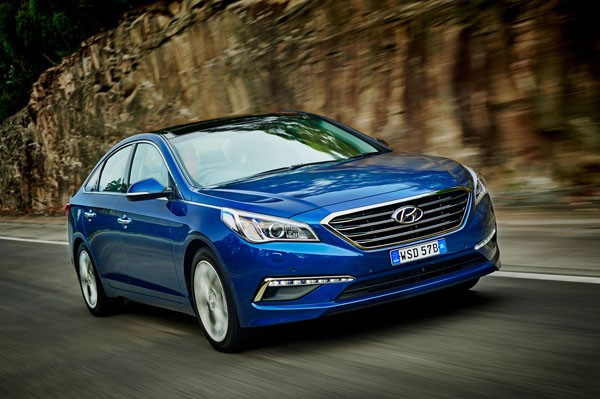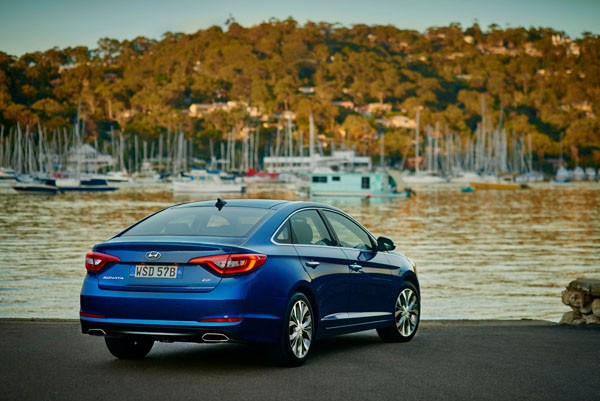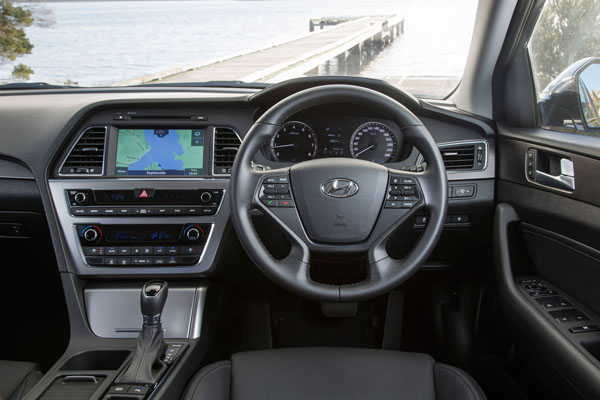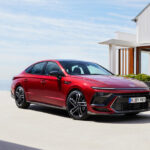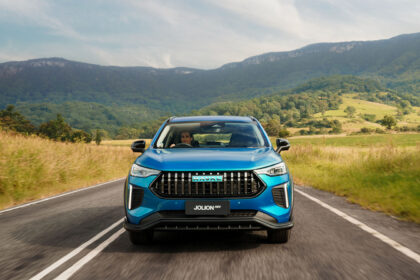The Australian launch of the Hyundai Sonata turned out to be something of a homecoming for the South Korean-made sedan. For, as well as hot weather testing the seventh generation Sonata in the outback, Hyundai’s local suspension development team ran the rule over the car’s driving dynamics.
During thousands of kilometres of testing our boys tailored the medium-size sedan to cope with some of our worst roads and how we drive. For example, six disguised mules covered more than 50,000 kilometres in three months on roads that included sections little more than goat tracks.
Finally, last summer a durability sign-off took place in outback Australia, where a Sonata test car covered more than 100,000 km in four months, leading to modifications to underbody components, engine air intake and vehicle sensors.
Also in the mix is a stiffer, lighter body made up of high-strength steel in more than half the platform, resulting in 41 per cent firmer torsional rigidity.
During a launch drive in Tasmania, in conditions not quite as testing as during development, the Sonata not once wavered from the job in hand – tackling the twists and turns of some challenging country roads with rubber at all times firmly planted on the bitumen. Thanks to firm and responsive steering, tight corners and fast bends came and went with nary a flicker of hesitation in keeping on track.
With styling cues from the Genesis, the new large sedan with which Hyundai is taking on the Europeans at the high end of the market, the new Sonata takes the shape, and at Cd 0.27, good aerodynamic properties.
New Hyundai Sonata comes in three specification levels – Active, Elite and Premium – with the choice of two petrol engines, a 2.0-litre turbocharged, for Elite and Premium, and 2.4-litre naturally aspirated unit in the entry-level Active.
Both engines are mated with Hyundai’s six-speed automatic transmission with sequential manual shift mode.
Under-bonnet noise is kept at bay from the cabin interior, Hyundai engineers reducing the size of apertures in the bulkhead and increasing the use of sound-deadening materials in the dashboard. More sound absorption materials are used under the floor.
An underbody tray helps reduce road noise while improving vehicle aerodynamics.
The launch vehicles sliced through the air quietly, while both engines were responsive to the throttle and answered back audibly only under hard acceleration.
The manufacturer’s fuel consumption figures claim 8.3 litres per 100 kilometres for the 2.4-litre unit and 9.2 litres per 100 kilometres from the 2.0-litre turbo on the combined urban / highway cycle – not the most frugal for a modern four-cylinder motor.
With 25 mm more rear legroom over its predecessor, new Sonata competes with Toyota Camry and Mazda6, in most dimensions.
All three Sonata variants come standard with a Touchscreen Multimedia System. Large colour TFT LCD displays (4.3-inch on Active, 8.0-inch on Elite and Premium) offering a wide range of connectivity through USB, Aux, digital iPod, and Bluetooth, as well as six speakers, including two front tweeters.
Elite and Premium variants feature satellite navigation, incorporating Here maps, Suna live traffic updates, and a comprehensive Point of Interest database. Also included is Here MapCare, where up to three years’ free map updates are included when the vehicle is serviced at participating authorised Hyundai dealers.
Each model has a rear-view camera and four-sensor rear parking assist system as standard, with Premium featuring an additional four-sensor front parking assist system.
Centre-console mounted rear air-conditioning vents come across the range, while Elite and Premium also feature dual-zone climate control air-conditioning.
Sonata Premium boasts a windscreen de-fog system, which automatically adjusts the climate control system to clear the windscreen when condensation is detected.
Active’s upholstery is cloth-trimmed, while Elite and Premium seats are leather-appointed. Sonata Elite and Premium each feature a 12-way electrically adjustable driver’s seat, including four-way lumbar support, while Premium also comes standard with an eight-way electrically adjustable front passenger seat, along with a memory system for the driver’s seat and exterior mirrors. Both front seats are heated and ventilated.
With six airbags, high strength body shell and integrated active safety systems, the new Sonata has achieved the maximum five-star ANCAP safety rating for all variants.
Active safety comes courtesy of Hyundai’s Vehicle Stability Management, consisting of Electronic Stability Control, Traction Control, and Anti-lock Braking with Electronic Brake-force Distribution, Brake Assist and Motor Driven Power Steering.
When emergency braking is detected, the Sonata’s Emergency Stop Signal automatically flashes the brake lights to alert surrounding vehicles. When the vehicle comes to a stop, the hazard lights automatically activate to provide an ongoing warning. The system is deactivated when the vehicle starts moving again.
Daytime running lamps and automatic dusk-sensing headlights are standard across the all-new Sonata range. The stylish LED Daytime Running Lamps are located in the front bumpers.
Bi-xenon headlights with cornering lights (Premium) offer significantly brighter illumination on both low and high-beam settings than conventional halogen lighting. The Sonata’s automatic levelling system reduces glare for oncoming drivers by compensating for vehicle load.
Auto-hold (Premium) automatically holds the brakes on once the vehicle has come to a stop, preventing movement should the driver take his or her foot off the brake pedal and Hill-start Assist automatically applies the brakes for up to two seconds after the brake pedal is released when the vehicle is on an incline.
An Active Collision Warning system will be added to the Sonatas later in the year. There will be no station wagon, that will be left to the corresponding Hyundai i40 range.
Active and Elite variants are shod with 17-inch alloy wheels as standard, the top-spec Premium variant features 18-inch alloys. A full-size spare wheel is standard across the range.
Prices start at $29,990 for the entry-level 2.4 Active; the 2.0 Elite adds $7000 to the price, while the 2.0 Premium tops out the range at $41,990. All prices exclude on-road costs.
The new Sonata marks the return of Hyundai Australia’s longest-serving nameplate after a five-year hiatus. The first-generation Sonata debuted in Australia in 1989 and, as I recall, had rubber floor covering and mats, and was as draughty as a mediaeval castle. How things have changed.




